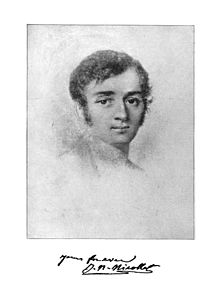Jean Nicholas Nicollet
| Joseph Nicollet | |
|---|---|

Portrait and autograph of J.N. Nicollet
|
|
| Born |
July 24, 1786 Cluses, Savoy, France |
| Died | September 11, 1843 (aged 57) Washington D.C, United States |
| Nationality | French |
| Occupation | Explorer, mathematician |
| Known for | Cartography of the Mississippi River |
Joseph Nicolas Nicollet (July 24, 1786 – September 11, 1843), also known as Jean-Nicolas Nicollet, was a French geographer, astronomer, and mathematician known for mapping the Upper Mississippi River basin during the 1830s. Nicollet led three expeditions in the region between the Mississippi and Missouri Rivers, primarily in Minnesota, South Dakota, and North Dakota.
Before emigrating to the United States, Nicollet was a professor of mathematics at Collège Louis-le-Grand, and a professor and astronomer at the Paris Observatory with Pierre-Simon Laplace. Political and academic changes in France led Nicollet to travel to the United States to do work that would bolster his reputation among academics in Europe.
Nicollet's maps were among the most accurate of the time, correcting errors made by Zebulon Pike, and they provided the basis for all subsequent maps of the American interior. They were also among the first to depict elevation by hachuring and the only maps to use regional Native American placenames. Nicollet's Map of the Hydrographical Basin of the Upper Mississippi was published in 1843, following his death. Nicollet Tower, located in Sisseton, South Dakota is a monument to Nicollet and his work and was constructed in 1991.
Nicollet was born in the French Alpes city of Cluses, Savoy, France. He was very bright, showing aptitude in mathematics and astronomy that earned him a scholarship to the Jesuit college in Chambéry. He began teaching mathematics at age 19. In 1817, he was appointed as a professor and astronomer at the Paris Observatory and worked with scientist and mathematician Pierre-Simon Laplace. While working at the observatory, Nicollet discovered a comet and built a reputation as an expert in astronomy and physical geography. During the 1820s, he worked as a mathematics professor at the Collège Louis-le-Grand.
...
Wikipedia
